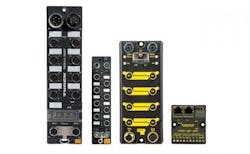Network Communicates as a Single Device
BEEP, the Backplane Ethernet Extension Protocol, helps users save on PLC costs by creating high-density I/O networks from a single point on their existing PLCs.
BEEP technology allows a network of up to 33 devices (one master + 32 slaves) or 480 bytes of data to appear to the PLC as a single device on a single connection using a single IP address. By reducing the number of connections the PLC sees, the user will be able to create high-density I/O networks and still utilize their low-cost PLC.
This technology is utilized by making the first device in the line a BEEP master, which can be done via the device webserver. The BEEP master can then scan the entire network and create a new data map that includes all the downstream devices, with all device configuration options saved in the master.
BEEP also supports drop-in device replacement, reducing downtime and overall expenses. If the network is setup using BEEP, a technician can simply replace a slave device with a new device to keep the system online. The BEEP master will automatically recognize the device, assign it an IP address, and download the parameters to it.
BEEP technology has been integrated into many of Turck’s multiprotocol digital block I/O modules, including the BL Compact push button station, the TBEN-L and TBEN-S digital stations, and several variants of the FEN20 module. Additionally, BEEP is compatible with all standard Ethernet components and does not require special equipment.
